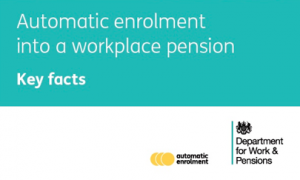Pension Autoenrolment Overview
 It has been well established that there will be a retirement savings deficit in the UK so in order to protect people when they reach retirement age the government put in place a pensions autoenrolment system in 2012. it is designed to sweep up all employees who don’t have a pension. Employees will be eligible if they:
It has been well established that there will be a retirement savings deficit in the UK so in order to protect people when they reach retirement age the government put in place a pensions autoenrolment system in 2012. it is designed to sweep up all employees who don’t have a pension. Employees will be eligible if they:
- Are already in a workplace pension scheme
- Are at least 22 years old
- Earn more £10,000 a year in 2015/16
- Work in the UK
- Are under State Pension Age
How does this affect companies?
Pension Autoenrolment started in 2012 and companies with more than 250 workers had to enroll their staff first.
Companies with less than 30 workers got involved in the process in 2016, they have been allowed longer because smaller companies have found it difficult to meet the requirements quickly. By 2018 all companies will need to have enrolled their workers.
I am an employer but don’t have a scheme, will I be fined?
If you are a company and don’t have a scheme you can set up one of your own or enroll their workforce into the National Employment Savings Trust (NEST).
What does NEST do?
NEST is run independently and operates a defined contribution pension scheme; it is designed for low-to-moderate earners and workers whose employer does not have a scheme.
If you are self employed you can also set up a personal pension.
NEST members can only add a maximum of £4,700 to their fund a year.
NEST charges are set at a 0.3% annual management charge and a start up charge of 1.8% charge on contributions.
NEST investment choices will be limited to five default funds and an ethical fund.
Not surprisingly NEST is currently dealing with a backlog.
What do we both put in the pension pot?
The smallest amount you are allowed to put in goes up year by year up to 2018.
It is worked out as a percentage of ‘qualifying earnings’ and ranges between £5,824 and £42,385 in 2015/16.
From 2012 to 2017, employees contribute 0.8% plus 0.2% tax relief, employers 1% (overall minimum is 2%)
From 2017 to 2018, employees contribute 2.4% plus 0.6% tax relief, employers 2% (overall minimum is 5%)
From 2018 onwards, employees contribute 4% plus 1% tax relief, employers 3% (overall minimum is 8%)
As a company what do I need to do?
A brief outline of the steps a company needs to follow would be as follows
Depending on the size of your company you have to meet the staging date.
- You will need to identify the different categories of work and workers that you have in your company.
- You may be eligible for a postponement but you have to apply for this to avoid a fine.
- As a company with employees you will need to process your pension scheme membership outside of the normal automatic enrolment.
- Within your company there will be workers who are able to opt out. These must be processed to avoid penalties. The company must provide an accurate record system by law this is one of your duties as an employer.
- The whole aim of the pension autoenrolment process is to get the workers back into some sort of pension scheme membership to provide for them in later life.
- These guidelines for pension autoenrolment comprise of 510 pages, they are a bit wordy to say the least.
- Every company must be aware of their staging date and a plan to meet auto enrolment requirements. Unfortunately this takes a while to put everything in place. If you miss your staging date there may be a fine to pay.
Pension AutoEnrolment summary?
To summarise your company will need to put in place 5 phases to successfully meet the auto enrolment conditions.
- You will need to one assess your workforce
- Talk to your employees to explain what auto enrolment is all about
- Choose a Pension Scheme and Fund
- Manage your data, which means pay your contributions and answer employee’s questions.
- Choose a pension scheme and fund and keep records to maintain your compliance. For help on choosing the right pension fund.
What is a discretionary Fund Manager?
A discretionary Fund Manager works for the benefit of the company or client and has to manage and protect the pension fund against potential falling markets.
Pension Autoenrolment Fines were mentioned earlier – What are the penalties?
Failure to comply: £400 immediate fine and additional daily fines:
| Number of Employees | Daily Fine Rate |
| 1 – 4 | £50 |
| 5 – 49 | £500 |
| 50 – 249 | £2,500 |
| 250 – 499 | £5,000 |
| 500+ | £10,000 |
If you are worried about company fines there may well be ways of avoiding them so feel free to get in touch.
Recent Changes in Pension Autoenrolment
In conclusion as the staging dates roll on so smaller and smaller companies need to comply, the experience of larger companies has lead to some recent changes.
For more detailed information on Recent Changes in Pension Auto enrolment, Get in contact for free advice.
Pension Autoenrolment Solutions?
- Do Nothing
- Do It Yourself
- Mainstream providers
- Nest
Contact Us to put you in touch with Pension Autoenrolment specialists for a free chat about your options.
